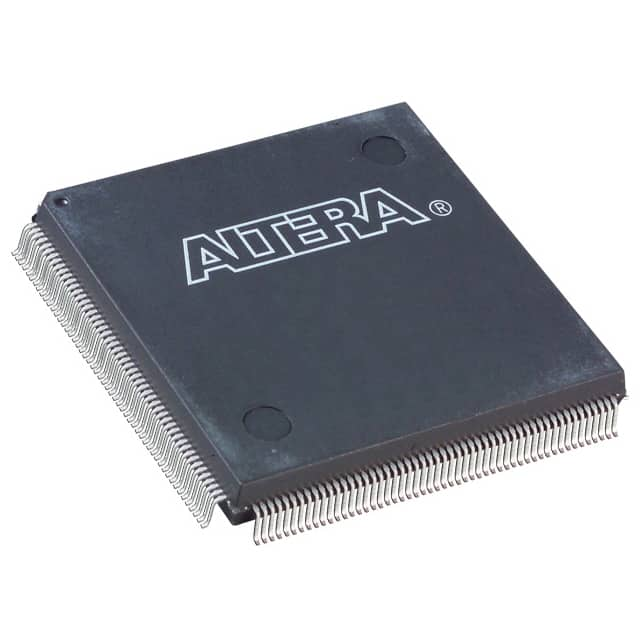EPM7512AEQI208-10N
Product Overview
Category
The EPM7512AEQI208-10N belongs to the category of programmable logic devices (PLDs).
Use
This device is primarily used in digital circuit design and implementation. It provides a flexible and customizable solution for various applications.
Characteristics
- Programmable: The EPM7512AEQI208-10N can be programmed to perform specific functions, allowing for versatility in circuit design.
- High Integration: This PLD offers a high level of integration, combining multiple logic gates and flip-flops into a single device.
- Low Power Consumption: The EPM7512AEQI208-10N is designed to operate efficiently with low power consumption.
- Fast Operation: With its advanced architecture, this device enables fast operation and response times.
Package
The EPM7512AEQI208-10N comes in a 208-pin quad flat pack (QFP) package.
Essence
The essence of this product lies in its ability to provide reconfigurable logic functionality, allowing designers to implement complex digital circuits with ease.
Packaging/Quantity
Each package of the EPM7512AEQI208-10N contains one unit of the programmable logic device.
Specifications
- Operating Voltage: 3.3V
- Logic Elements: 512
- Macrocells: 128
- Maximum Frequency: 100 MHz
- I/O Pins: 208
- Memory Capacity: 4,096 bits
Detailed Pin Configuration
The EPM7512AEQI208-10N has a total of 208 pins, each serving a specific purpose in the device's operation. A detailed pin configuration diagram can be found in the product datasheet.
Functional Features
- Reconfigurable Logic: The EPM7512AEQI208-10N allows users to modify the logic functions it performs, providing flexibility in circuit design.
- In-system Programming: This PLD can be programmed while in operation, eliminating the need for physical reconfiguration.
- JTAG Support: The device supports Joint Test Action Group (JTAG) interface for programming and debugging purposes.
Advantages and Disadvantages
Advantages
- Flexibility: The EPM7512AEQI208-10N offers a high degree of flexibility, allowing designers to adapt their circuits as needed.
- Integration: With its high integration level, this PLD reduces the need for additional components, saving space and cost.
- Fast Prototyping: The reconfigurable nature of this device enables rapid prototyping and iterative design processes.
Disadvantages
- Complexity: Utilizing the full potential of the EPM7512AEQI208-10N requires expertise in digital circuit design and programming.
- Limited Memory Capacity: Compared to other PLDs, the memory capacity of this device may be insufficient for certain applications.
Working Principles
The EPM7512AEQI208-10N operates based on the principles of programmable logic. It consists of an array of configurable logic blocks interconnected by programmable interconnects. These blocks can be programmed to perform specific logic functions, enabling the implementation of complex digital circuits.
Detailed Application Field Plans
The EPM7512AEQI208-10N finds applications in various fields, including: 1. Industrial Automation: Used in control systems for process automation and monitoring. 2. Communications: Employed in network routers and switches for data processing and routing. 3. Automotive Electronics: Integrated into automotive control units for managing vehicle systems. 4. Consumer Electronics: Utilized in multimedia devices, gaming consoles, and home automation systems.
Detailed and Complete Alternative Models
- EPM7128SLC84-10N: A similar PLD with 128 logic elements and 84-pin package.
- EPM7064STC44-10N: Another alternative with 64 logic elements and a 44-pin package.
- EPM7256AETC144-10N: Offers higher logic capacity with 256 logic elements and a 144-pin package.
These alternative models provide different options based on specific project requirements, offering varying levels of logic capacity and pin configurations.
In conclusion, the EPM7512AEQI208-10N is a programmable logic device that provides flexibility, integration, and fast operation for digital circuit design. While it offers advantages such as reconfigurability and high integration, it also has limitations in terms of complexity and memory capacity. With its wide range of applications and alternative models available, this PLD serves as a valuable tool in various industries.
قم بإدراج 10 أسئلة وإجابات شائعة تتعلق بتطبيق EPM7512AEQI208-10N في الحلول التقنية
Question: What is the EPM7512AEQI208-10N?
Answer: The EPM7512AEQI208-10N is a specific model of Field-Programmable Gate Array (FPGA) manufactured by Intel.Question: What are the key features of the EPM7512AEQI208-10N?
Answer: The key features of this FPGA include 7512 logic elements, 208-pin Quad Flat Package (QFP), and a maximum operating frequency of 10 nanoseconds.Question: What are some typical applications for the EPM7512AEQI208-10N?
Answer: This FPGA can be used in various technical solutions such as digital signal processing, high-speed data communication, industrial automation, and embedded systems.Question: How does the EPM7512AEQI208-10N differ from other FPGAs?
Answer: The main difference lies in its specific configuration, pin count, and performance characteristics. It is important to choose the right FPGA based on the requirements of your application.Question: Can the EPM7512AEQI208-10N be reprogrammed?
Answer: Yes, FPGAs are designed to be reprogrammable, allowing users to modify their functionality even after deployment.Question: What development tools are available for programming the EPM7512AEQI208-10N?
Answer: Intel provides Quartus Prime software, which is widely used for designing, simulating, and programming FPGAs.Question: Are there any limitations or constraints when using the EPM7512AEQI208-10N?
Answer: Like any electronic component, this FPGA has certain limitations such as power consumption, temperature range, and I/O voltage levels. These should be considered during the design phase.Question: Can the EPM7512AEQI208-10N interface with other electronic components?
Answer: Yes, this FPGA can interface with various devices such as microcontrollers, sensors, memory modules, and communication interfaces through its I/O pins.Question: What is the expected lifespan of the EPM7512AEQI208-10N?
Answer: The lifespan of an FPGA depends on various factors such as operating conditions, usage patterns, and environmental factors. However, FPGAs are generally designed to have a long operational life.Question: Where can I find more information about the EPM7512AEQI208-10N?
Answer: You can refer to the official documentation provided by Intel, including datasheets, application notes, and user guides. Additionally, online forums and communities dedicated to FPGA development can be helpful sources of information.


